
- TOP>
- Protect>
- Efforts of JNCAP>
- Child Seat Assessment>
- Test Procedures and Evaluation Methods for frontal collision evaluation test

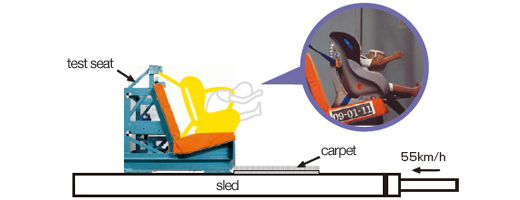
In this test, a child dummy is placed in a child seat installed in the test seat fixing on the sled,then the sled accelerated equivalent front collision speed of 55 km/h (this collision speed is 10 % higher than the government regulated frontal collision speed). Then, evaluation of the damage of CRS installation arear, resultant acceleration on a dummy's head and chest, excursion distance of a dummy head and aggresiveness under the condition of restrained by the harness are measured.

From FY2009, test seat installing CRS was changed from Toyota ESTIMA seat to the test seat using for the test of safety technical regulation of CRS.
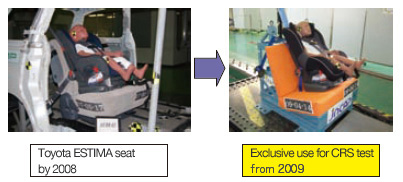
 |
(Excellent) Product was given 4 ◎ marks (No × marks) |
|---|---|
 |
(Good) Product was given 3 ◎ marks and 1 ○ mark (No × marks) |
 |
Product not falling into any of the other 3 ratings (Excellent, Good, Not recommended) |
 |
Product received an mark in any of the test areas. This rating indicates that the product does not have the high level of safety here being determined, and does not mean that the product cannot be used. All products tested have the level of safety meeting relevant safety regulations. |
* Impact shield type child seat (using vehicle seatbelt restrained both impact shield (restraining system to prevent ejection of child body in the occasion of crash) and child simultaneously), due to dummy chest and abdomen is received great deformation which is over measurement range, and some cases can not measure pressure on abdomen properly. Due to this reason, we did not conduct overall evaluation of this type of CRS since 2003. In addition that evaluation method of chest deflection and evaluation method of pressure on the abdomen are not established evaluation methods, therefore, we did not conduct overall Evaluation from 2009.
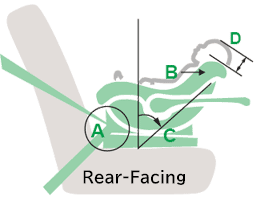
| A. Damage of such as fixtures | |
|---|---|
| ◎ | No damage on the fixtures |
| ○ | Slight damage (such as crack, etc.) and maintained restraint |
| × | Terribly damaged structure and did not maintain function |
| B. Chest received force (Chest resultant acceleration) | ||
|---|---|---|
| ◎ | Chest r. acceleration <= 490m/s2 (50G) (*1) | [ C.R.A <= 539m/s2(55G) ] |
| ○ | 490m/s2 (50G) Chest r. acceleration (*1) | [ 490m/s2 (50G) < CRA ] |
(*1) New evaluation threshold is shown due to the change of test seat. [ ] shows old values used by 2008.
| C. Projection position of dummy head from top surface of CRS | ||
|---|---|---|
| ◎ | seat back angle <= 55° (*1) | [ seat back angle <= 60 deg. ] |
| ○ | 55° < seat back angle <= 63° (*1) | [ 60° < seat back angle <= 70° ] |
| × | 63° < seat back angle (*1) | [ 70° < seat back angle ] |
(*1) New evaluation threshold is shown due to the change of test seat. [ ] shows old values used by 2008.
| D. Projection position of dummy head from top surface of CRS | |
|---|---|
| ◎ | No projection |
| ○ | within 73 mm projection of head |
| × | Over 73 mm projection of head |
(*1) New evaluation threshold is shown due to the change of test seat. [ ] shows old values used by 2008.
| Other | |
|---|---|
| × | Released of buckle during crash |
| × | CRS ejected from vehicle seatbelt |
 |
(Excellent) Product was given 4 ◎ marks (No × marks) |
|---|---|
 |
(Good) Product was given 3 ◎ marks and 1 ○ mark (No × marks) |
 |
Product not falling into any of the other 3 ratings (Excellent, Good, Not recommended) |
 |
Product received an mark in any of the test areas. This rating indicates that the product does not have the high level of safety here being determined, and does not mean that the product cannot be used. All products tested have the level of safety meeting relevant safety regulations. |
* Impact shield type child seat (using vehicle seatbelt restrained both impact shield (restraining system to prevent ejection of child body in the occasion of crash) and child simultaneously), due to dummy chest and abdomen is received great deformation which is over measurement range, and some cases can not measure pressure on abdomen properly. Due to this reason, we did not conduct overall evaluation of this type of CRS since 2003. In addition that evaluation method of chest deflection and evaluation method of pressure on the abdomen are not established evaluation methods, therefore, we did not conduct overall Evaluation from 2009.
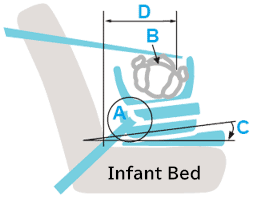
| A. Damage of such as fixtures | |
|---|---|
| ◎ | No damage on the fixtures |
| ○ | Slight damage (such as crack, etc.) and maintained restraint |
| × | Terribly damaged structure and did not maintain function |
| B. Chest received force (Chest resultant acceleration) | ||
|---|---|---|
| ◎ | Chest r. acceleration <= 490m/s2 (50G) (*1) | [ C.R.A <= 539m/s2(55G) ] |
| ○ | 490m/s2 (50G) Chest r. acceleration (*1) | [ 490m/s2 (50G) < CRA ] |
(*1) New evaluation threshold is shown due to the change of test seat. [ ] shows old values used by 2008.
| C. Projection condition (Projection of the head from CRS, bottom angle of bed) | |
|---|---|
| ◎ | Bottom of bed rotated reaward (No projection of head) |
| ○ | No rotation bottom of bed (No projection of head) |
| × | Bottom of bed rotated forward or projection of head occured |
| D. Projection position of dummy head from top surface of CRS | ||
|---|---|---|
| ◎ | excursion <= 575 mm (*1) | [ excursion <= 600 mm ] |
| ○ | 575 mm < excursion <= 650 mm (*1) | [ 600mm < excursion <= 750 mm ] |
| × | 650 mm < excursion (*1) | [ 750mm < excursion ] |
(*1) New evaluation threshold is shown due to the change of test seat. [ ] shows old values used by 2008.
| Other | |
|---|---|
| × | Released of buckle during crash |
| × | CRS ejected from vehicle seatbelt |
 |
(Excellent) Product was given 4 ◎ marks (No × marks) |
|---|---|
 |
(Good) Product was given 3 ◎ marks and 1 ○ mark (No × marks) |
 |
Product not falling into any of the other 3 ratings (Excellent, Good, Not recommended) |
 |
Product received an mark in any of the test areas. This rating indicates that the product does not have the high level of safety here being determined, and does not mean that the product cannot be used. All products tested have the level of safety meeting relevant safety regulations. |
* Impact shield type child seat (using vehicle seatbelt restrained both impact shield (restraining system to prevent ejection of child body in the occasion of crash) and child simultaneously), due to dummy chest and abdomen is received great deformation which is over measurement range, and some cases can not measure pressure on abdomen properly. Due to this reason, we did not conduct overall evaluation of this type of CRS since 2003. In addition that evaluation method of chest deflection and evaluation method of pressure on the abdomen are not established evaluation methods, therefore, we did not conduct overall Evaluation from 2009.
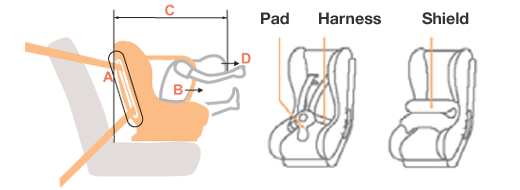
| A. Damage of such as fixtures, etc. | |
|---|---|
| ◎ | No damage on the fixtures of CRS |
| ○ | Slight damage (such as acrack) and CRS is restrained |
| × | Terrible damage and did not keep original structure |
| B. Chest resultant acceleration | |
|---|---|
| ◎ | Chest resultant acceleration <= 588 m/s2 (60G) |
| ○ | 588 m/s2 (60G) < Chest resultant acceleration |
| C. Head excurtion in forward direction | ||
|---|---|---|
| ◎ | Excursions <= 525mm (*1) | [ Excursion <= 550mm ] |
| ○ | 525mm < Excursion <= 600mm (*1) | [ 550mm < Excursion <= 700mm ] |
| × | 600mm < Excursion (*1) | [ 700mm < Excursion ] |
(*1) New evaluation threshold is shown due to the change of test seat shows old values used by 2008.
| D. Head resultant acceleration | ||
|---|---|---|
| ◎ | Head resultant acceleration <= 637m/s2 (65G) (*1) | [ H.R.A. <= 5784m/s2 (80G) ] |
| ○ | 637m/s2 (65G) < Head resultant acceleration (*1) | [ 784m/s2 (80G) < H.R.A. ] |
(*1) New evaluation threshold is shown due to the change of test seat shows old values used by 2008.
| Others | |
|---|---|
| × | Buckle is released in occasion of crash test |
| × | CRS is ejected from vehicle seatbelt during crash |
| × | Have some possibility of injury on weak area of abdomen by pressure in occasion of crash * In the case of toddler, harness or shield is necessary to restrain the body on shoulder and pelvis. This case is applicable to be not properly restrained, or weaker parts of bosy such as neck, abdomen and crotch, etc. pressure on the abdomen is measured by pressure meter and its value is over 1.30 KN (1.38 kN by 2008), its become X. |
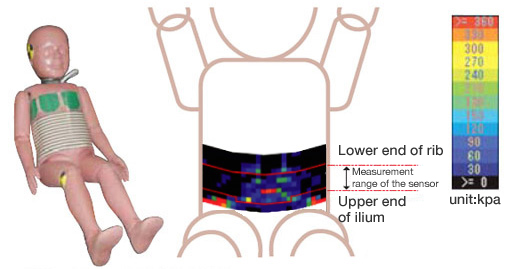
Due to the CRS which causes high pressure on the toddler's abdomen, quantitative measurement of the pressure on the abdomen is measured to install pressure meter on the abdomen of the dummy during test since FY 2003.
Total abdominal loads added each pressure on the abdomen which is considered from lower end of rib to upper end of ilium, and consided that its value can be evaluated degree of the injury for the toddler. Over 1.30 kN (* 1.38 kN was used by 2006) become evaluation of [X] mark.
(1) 3 years old dummy (Hybrid-III 3YO) used for test is not same as the human and has the structure not to deform over 50 mm on abdomen. Additionally, chest structure has not deform over 40 mm, therefore distance of deformation are different. For this reason, in the case that the limits of pressure is added on these parts, measured pressures of abdomen and chest are not correct values.
(2) Regarding distribution chart when abdominal total loads become maximum, simply easy to understand the pressure distribution when maximum load is appled, and this is not showed actual area of pressure.

In abdominal pressure measurement,due to the problem of dummy structure, some time, it was measured correctly. To solve this problem, research was conducted in 2006 and 2007. Based on this study, reviewed evaluation range and modification of dummy was done.
Due to this review, abdominal overall load which is considered to provide injury to the toddler, was changed from 1.38 kN to 1.30 kN.
New evaluation range and modification of dummy was used starting in 2007.